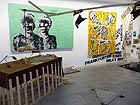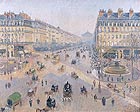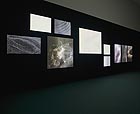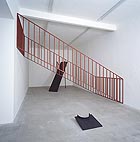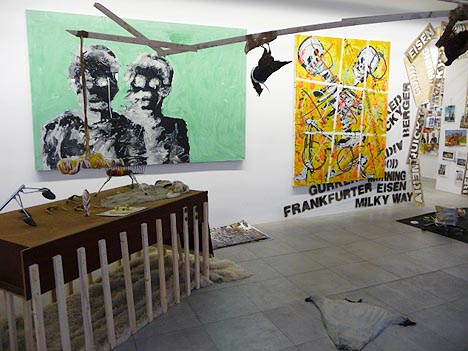
translated and summarized by: Liz Wollner-Grandville,
English summaries December 20 - January 9
Konzett Wien
Christian Eisenberger – IMG3171PSD
10.12.10 – 29.01.11
Amalgamated amusement
Zeus, the Thunder God, had the edge over all men of the ancient world: he was the head of all Gods and could not only afford his love life on account of his sparkling wit and his doe-eyed wife, but actually enjoy it to the full. His bolts of lightning must have been dreadful and exciting.
Nevertheless, Klimt depicted Zeus as a Shower of Gold over Danae - who seemed rather enchanted. Pollock refined the drippings as black and white rain and no longer needed Danae, and in his exhibition at the Konzett Gallery, Eisenberger also drips, massively, onto large and small canvases, large piles of paper, smaller piles of paper, dolls… with paint, glue, foils, spray cans, Edding - fixed onto very diverse materials.
In collages he mixes numerous images both naked and dressed with other pictures and forces astronauts to appear like naves and silhouettes of cars like intestines. The smaller objects, such as the installation of two tubes of glue in front of a tube lid frozen in glue, tubes sitting across from each other on small wooden benches or the bicycle handlebar with horns, bells, and lights together with the bill for these items remind of lightning as seen in art history or by Picasso, Duchamp and Camille Claudel. Drawings can be found on mirrors and Plexiglas and the most beautiful one is attached on the underside of the lowest drawer and can be looked at and enjoyed without being recognized as it is mirrored in a foil that obscures the lines.
In order to create a space of perception it is interesting to rouse the invisible. The majority of the large paper collages are mounted onto a roll, requiring the onlookers to unwind the roll – and those who don’t have enough muscle power will never see most of the collages. But for two pictures in the large room one doesn’t have to sweat. The portrait format shows the stenciled figure 14 and the Ganymede motive, in which Zeus – as an eagle - transports the infant Ganymede. On the landscape print there are two ghost faces in front of some refreshing greenery. The large installation includes all kinds of personnel: five concrete rolling stools, sprinkled legs and heads, sprinkled breathless male dolls, brooms in concrete stockings, an enthusiastic projection wall, a fishing rod with three large birds and a baby, a waist-high fence-like cage with fur and a hatch, a three-legged bicycle fruit basket, a bicycle handlebar with four mirrors.
No one would ask Zeus what his actions meant to achieve. Thunderstorms are known to be difficult to understand but easy to enjoy. One can hope to interpret the lightning or to sneeze or to tinkle with ones eyelashes. One doesn’t have to deal with Christian Eisenberger’s works in any other way, and one may amuse oneself.
By Gesche Heumann
Konzett Wien
1010 Vienna, Spiegelgasse 21
Tel: +43 664 34 01 677
Fax: +43 1 513 01 04
Email: gallery@artkonzett.com
www.artkonzett.com
Opening hours: Tue – Fri: 10 a.m. – 6 p.m., Sat: 11 a.m. – 4 p.m.
Museum Folkwang
Images of a capital. The Impressionists in Paris
02.10.10 – 30.01.11
Paris, devoid of dogs
“I want some apple juice!” – my four and a half-year old daughter and I had just entered the first of 13 rooms of the exhibition at the Folkwang Museum in Essen, when she asked: “when are we leaving?”
Admittedly, the exhibition: “Images of a capital. The Impressionists in Paris” is not really suitable for children, but I had hoped for a little more patience. But then I had a brainwave: “Did you see the dogs?” – “Where are they?” This is how our walk through the exhibition lasted for 45 minutes without any more expressions of displeasure.
The first dog appears practically out of the blue. We march into the central room of the exhibition – in the opposite direction of the exhibition choreography. Here a rather ragged specimen runs across the picture of the Pont de l’Europe by Gustave Caillebotte (1876). Who is the owner? The stylish couple with the umbrella? More likely the man in the gown, who so obviously turns away from the strolling couple and looks down towards the railroad tracks. Two outsiders who don’t fit into the picture of the embellished capital.
We continue through the show and encounter great names: van Gogh, Manet, Monet, Renoir. And detached from the somewhat random arrangement we experience “a fascinating walk through the capital of the 19th century” – as the director of the museum, Hartwig Fischer, promises that one would.
But no matter where we go – be it Renoir’s Dance in the Moulin de la Galette or the Avenue de l’Opera, or a Sunny Winter Morning by Camille Pissaro - everything is clean, bright, and devoid of dogs.
Then we discover two four-legged friends in front of the Grocery Store in the Rue des Abbesses. Together with Maximilien Luce we reach the outskirts of a new city, the Montmartre District. And thanks to George Seurat we come upon a happy little dog prancing on the banks of the Seine River near Courbevoie. My daughter and I agree: we’re through half the exhibition and there were only four dogs, how disappointing.
Why are there so few dogs? No idea, maybe just a coincidence. And maybe it’s symbolic for the young, the bright and civilized Paris of Baron Haussmann. But how should I explain that?
Well, at that time they had just built many new houses. With wide streets and water pipes and sewage systems. They didn’t have any of that before? No, the houses were old and stood close together. And that’s why they weren’t allowed to have dogs? I don’t know, but maybe the artists wanted to show that everything was cleaner now. – That’s funny.
We discover three more dogs in the exhibition: first we encounter the one by Adolph Menzel. The guest – not only is he from Berlin but also from another time – depicts a Parisian Weekday: to him the tall town houses are only decoration. In front of them there are masses of people: exotic people with turbans, elegant coffee shop visitors, and nannies that all seem to be in a hurry. Someone strolling along would not survive. And somewhere in this bustle we find two dogs crawling around in the half-shade.
After all of this detective work the seventh dog presents itself without much ado: in Edouard Manet’s Train (1873) we come across a young lady and a girl. Are they sisters? Both are elegantly dressed in white and blue. While the girl looks at the locomotive in the background the young lady faces us. She looks over to us in a relaxed but somewhat impassive way and practically ignores the little dog on her lap.
Later we see the painting over and over again. It’s on the poster advertising the exhibition. “I know her”, my daughter says, “she is sad because she moved to a large house and isn’t allowed to keep the dog. Paris is such a stupid city full of houses.”
By Torsten Kohlbrei
Museum Folkwang
45128 Essen, Kahrstrasse 16
Tel: +49 201 88 45 301
Fax: +49 201 88 45 330
Email: info@museum-folkwang.essen.de
www.museum-folkwang.de
Opening hours: Tue – Sun 10 a.m. 8 p.m., Fri 10 a.m. – 10.30 p.m.
Kunstraum Bernsteiner
Sylvia Eckermann: Naked Eye
01.12.10 – 22.01.11
In the center of the room
With her multimedia installation “Naked Eye” the artist Sylvia Eckermann succeeds in transforming the Kunstraum Bernsteiner into a video- and soundscape, which evokes moments of the subconscious in an interdisciplinary synopsis of illustrative and audio components.
On ten projection screens of various sizes, with Swarovski crystals incorporated in their surface to increase the picture’s intensity and brightness, three different videos are beamed creating a chain of narration of picture elements, which leaves it up to the viewers to develop their own ideas.
Peter Szely’s sound carpet was commissioned especially for the works presented and flows into the room that was furnished with a dark green carpet, which turns into a deep black on the wall, as a meditative composition that allows one to emerge into the pictures; this in turn induces a lingering in the newly created artistic world far beyond the actual length of the projected video.
The pictures center on silhouette-like depictions of body images (photographed by the artist’s son while washing his hands) to the rendering of skull parts and horizontal signal lines that flow from the top down across all projection levels and thereby evoke a synchronicity of the image parts in an ontologic-spiritual white.
Individual parts of the image overlap on the different projection surfaces - this leads to an overall composition in which the viewers attempt to identify the individual parts of the happening, respectively the digitally generated and projected content. Eckermann succeeds in creating a precisely constructed and composed world, tailored specifically for the Kunstraum Bernsteiner, allowing for an art experience that goes far beyond everyday reality.
By Walter Seidl
Kunstraum Bernsteiner
1020 Vienna, Schiffamtsgasse 11 (Courtyard)
Tel: +43 664 307 70 97
Email: mail@friendsandart.at
www.friendsandart.at
Opening hours: on request
Galerie Martin Janda
Raum aktueller Kunst: Werner Feiersinger
17.11.10 - 15.01.11
Reverently!
Werner Feiersinger’s sculptures, similar to those by the other Austrian “Minimalist” Heimo Zobernig, lack associative titles. All of Feiersinger’s works are characterized by the absence of corporeality, volume or transparency and they lack all that is common to the term sculpture. His works deal with monuments of classic modernism in a surprisingly fashion-resistant manner. Among them are the heroes of international style – architecture, design and lifestyle by Le Corbusier, Mies van der Rohe or Mendelsohn. In the eyes of numerous critics, Feiersinger’s works “are a polymorph confusion between the utility object, architecture and sculpture” that, “on account of differently connoted reference areas” and at the same time, with investigative impulse, unfold “hybrid energies”. In our time, in which “super architects “ form new alliances with commercialized space and a triumph of superficiality is celebrated (as recently in Vienna: Hotel Sofitel by Jean Nouvel) the artist’s color- and shape-reduced “furniture-like” steel objects stand out from the realistic construction culture and its high-tech decor.
With photography Feiersinger demonstrates the method of visual seduction and bereaves it of its hypnotic effect. In the current exhibition at the Gallery Janda the sculptor reconstructs and re-actualizes everyday utilities, tools, symbols and architectural motives and attempts to make that what is ignored more visible symbolically.
A huge reddish brown railing fixed diagonally across the entrance area, whose handrail refers to the one in the Vienna Stadion Bad (built 1931) and a black shiny board with two useless retainers appear rather precarious. All insignias of functionality are more than uncertain. The black floor sculpture positioned in front presents itself shadowy and flat – reminding of a guillotine or a clergyman.
The white pedestal in the adjoining room presents itself in an eerie and abstracted manner, its octagonal shape refers to the former Pan Am building in New York. The green grid pattern lets a wooden board appear as if it was locked up in a cage, seeming to wait for its ordeal like St. Lawrence. A symbol of global spiritual sovereignty? The traumatic sculptural pictures turned into an indicator of an internalized imagery that carries the discourse with modernistic conceptions further and onto a more complex level – this time under the premise of socially prefabricated identity constructions. True art deals with life and death, one reverently says.
By Goschka Gawlik
Galerie Martin Janda Raum aktueller Kunst
1010 Vienna, Eschenbachgasse 11
Tel: +43 1 585 73 71
Fax: +43 1 585 73 72
Email: office@raumaktuellerkunst.at
www.martinjanda.at
Opening hours: Tue – Fri 11 a.m. – 6 p.m., Sat 11 a.m. – 3 p.m.
Mehr Texte von translated and summarized by: Liz Wollner-Grandville


 Teilen
Teilen

